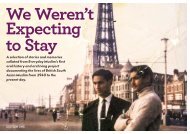Race, Faith and Community in Contemporary Britain Essays on Black, African, and African Caribbean Muslims in the UK PROUDLY MUSLIM & BLACK REPORT 2022
Black British Muslims play an important role in British society but are poorly represented in public discourse, policy, and indeed across a range of sectors. To overcome structural disadvantages and racism in society and in Muslim communities, we aim to create a platform for interventions in discourse and representation as well as in power relations. Our effort is collaborative and aimed at exploring the diversity, contributions, heritage, as well as the history of Black British Muslims. Our objective in this report is to create a platform to review and consider the current state of race and power relations, while creating networks and partnerships. In short, bringing Black British Muslim voices to the forefront is to work towards inclusion and belonging in British society and importantly, in British Muslim communities.
Black British Muslims play an important role in British society but are poorly represented in public discourse, policy, and indeed across a range of sectors. To overcome structural disadvantages and racism in society and in Muslim communities, we aim to create a platform for interventions in discourse and representation as well as in power relations. Our effort is collaborative and aimed at exploring the diversity, contributions, heritage, as well as the history of Black British Muslims. Our objective in this report is to create a platform to review and consider the current state of race and power relations, while creating networks and partnerships.
In short, bringing Black British Muslim voices to the forefront is to work towards inclusion and belonging in British society and importantly, in British Muslim communities.
Create successful ePaper yourself
Turn your PDF publications into a flip-book with our unique Google optimized e-Paper software.
Court houses, unlike other public institutions, do not typically have adequate prayer facilities
for Muslims. Consequently, unoccupied conference rooms are makeshift prayer rooms while
ablutions are carried out in facilities that are not quite appropriate.
Most court professionals lack sufficient faith awareness to know and understand etiquettes of
interacting with Muslims i.e. shaking hands with the opposite sex, the requirement to have a
space to pray 5 times a day, the impact of fasting during Ramadan and having to attend court.
This is exacerbated for Black Muslims by the longstanding misconception that Black people
either can’t be Muslims, or aren’t ‘proper Muslims’ anyhow.
These issues go as far as the jury in Crown Court trials; a jury is supposed to guarantee you
judgment by your ‘peers’ but as a Black Muslim, your chances of seeing a Black Muslim juror,
particularly in certain parts of the UK, are slim to none. This understandably impacts the
perception of fairness and challenges the old adage of it being “as important for justice to be
seen to be done.”
Figure 2a: BAME Judicial Office Holders 14
Add to this all the microaggressions of having your name mispronounced, the data that
shows Black people are less likely to be considered victims but rather aggressors, and the
stereotypical criminalisation of Black and Muslim culture; there are then questions as to how
likely it is for Black defendants to receive a fair trial, free from bias. And how likely it is for Black
Muslim court users to have a positive experience of the court system to enable them to fully
and effectively participate in the justice process.
Conviction and Sentencing
The lack of diversity of both the judiciary and jurors has been highlighted previously, but now
we need to look at the impact of this. The British Judiciary is notoriously under-representative
of British society. It doesn’t reflect the communities it impacts and we see that minorities,
particularly Muslims and Black people receive disproportionately harsher sentences, leading
to their over representation in prisons.
The judicial diversity statistics (2019a) show that:
• Black, Asian and Minority Ethnic representation among judges in the court was
generally lower than the general population
• 12% of magistrates declared themselves as BAME
• There were very few magistrates aged under 40 (5%) compared with 52% of
magistrates who were aged 60 or over.
Looking at youth justice, we see that BAME people account for 50 per cent of young offenders
in prison (Aidara 2020)—this exponential rise taking place at a time when youth imprisonment
in general has fallen by a third. In the year ending March 2019, 27.8% of people in youth
custody were Black – more than double the percentage in the year ending March 2006 (12.5%)
(Ministryof Justice 2020).
Figure 2b: Representation of BAME judicial office holders 15
We often see the use of what are called ‘deterrent’ sentences, deployed as a means to deter
criminals who commit a certain type of crime so that they desist from committing said crime,
out of fear of the consequences, which are usually immediate custody or otherwise sentences
that are more ‘harsh’ than usual. Often such sentences end up being used to address crimes
that predominantly affect or involve Black communities which of course impacts the Black
Muslim community. In the UK we have seen this with the 2011 London riots, the Notting Hill
Carnival, knife crime offences, so-called gang offences (particularly those involving music
artists such as ‘Drill artists’) and joint enterprise laws.
14 ,15
See Courts and Tribunals Judiciary 2019b
92 93





